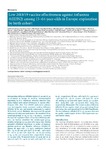Low 2018/19 vaccine effectiveness against influenza A(H3N2) among 15–64-year-olds in Europe: exploration by birth cohort
Kissling, Esther
Pozo, Francisco
Buda, Silke
Vilcu, Ana-Maria
Gherasim, Alin
Brytting, Mia
Domegan, Lisa
Gómez, Verónica
Meijer, Adam
Lazar, Mihaela
Višekruna Vučina, Vesna
Dürrwald, Ralf
van der Werf, Sylvie
Larrauri, Amparo
Enkirch, Theresa
O'Donnell, Joan
Guiomar, Raquel
Hooiveld, Mariëtte
Petrović, Goranka
Stoian, Elena
Penttinen, Pasi
Valenciano, Marta
I-Move primary care study team
Introduction
Influenza A(H3N2) clades 3C.2a and 3C.3a co-circulated in Europe in 2018/19. Immunological imprinting by first childhood influenza infection may induce future birth cohort differences in vaccine effectiveness (VE).
Aim
The I-MOVE multicentre primary care test-negative study assessed 2018/19 influenza A(H3N2) VE by age and genetic subgroups to explore VE by birth cohort.
Methods
We measured VE against influenza A(H3N2) and (sub)clades. We stratified VE by usual age groups (0–14, 15–64, ≥ 65-years). To assess the imprint-regulated effect of vaccine (I-REV) hypothesis, we further stratified the middle-aged group, notably including 32–54-year-olds (1964–86) sharing potential childhood imprinting to serine at haemagglutinin position 159.
Results
Influenza A(H3N2) VE among all ages was −1% (95% confidence interval (CI): −24 to 18) and 46% (95% CI: 8–68), −26% (95% CI: −66 to 4) and 20% (95% CI: −20 to 46) among 0–14, 15–64 and ≥ 65-year-olds, respectively. Among 15–64-year-olds, VE against clades 3C.2a1b and 3C.3a was 15% (95% CI: −34 to 50) and −74% (95% CI: −259 to 16), respectively. VE was −18% (95% CI: −140 to 41), −53% (95% CI: −131 to −2) and −12% (95% CI: −74 to 28) among 15–31-year-olds (1987–2003), 32–54-year-olds (1964–86) and 55–64-year-olds (1954–63), respectively.
Discussion
The lowest 2018/19 influenza A(H3N2) VE was against clade 3C.3a and among those born 1964–86, corresponding to the I-REV hypothesis. The low influenza A(H3N2) VE in 15–64-year-olds and the public health impact of the I-REV hypothesis warrant further study.
Dateien zu dieser Publikation

